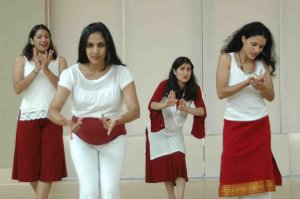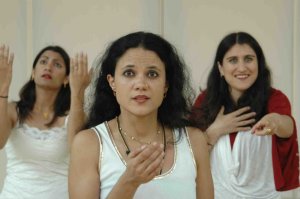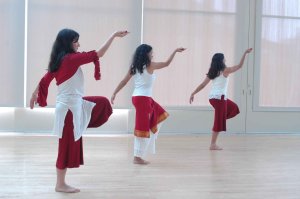
|
 |

|
 |
Post Natyam: A multinational Collective - Lalitha Venkat, Chennai e-mail: lalvenkat@yahoo.com Photos: Lilian Wu November 28, 2006  The Post Natyam Collective, a multinational collective of choreographers, explores contemporary Indian dance, performance and video on a continuum of tradition and innovation, theory and aesthetics, art and activism. The collective currently consists of Sandra Chatterjee (Germany/India), Shyamala Moorty (USA), Anjali Tata (USA) and Sangita Shresthova (Nepal/Czech Republic). They use their diverse artistic backgrounds, which include training in Bharatanatyam, Kuchipudi, Modern/Postmodern dance, Polynesian dance, Yoga, theater, and video to create thought provoking performances, workshops and lectures that address contemporary issues facing women with transnational identities. Post Natyam Collective presents MEET THE GODDESS On Dec 3, 2006 for The Other Festival at Museum Theatre (Chennai), 8pm. On Dec 8, 2006 for 3RD ADHYAYA organised by Nritarutya at Seva Sadan, 14th Cross, Malleshwaram, Bangalore, 6.30pm. Sandra, Shyamala, Anjali and Sangita speak about what holds their group together. How did you four get together to form a collective? We met at the Department of World Arts & Cultures at UCLA. As graduate students there we shared the experience and challenge of exploring contemporary Indian dance and performance (including theater and video/multi-media). Shyamala and Sandra had worked together on a project called InnerDiVisions before collaborating with Anjali, and later Sangita added the dimension of video/film for dance. Each choreographer / performer has trained in different dance forms (Bharatanatyam and Modern dance are the techniques we all have in common), and each of us continues to have a unique voice, unique experiences, and perspectives on what the contemporization of dance and performance can include. Trained in classical styles, what motivated you to venture into contemporary dance? When I began training in modern dance and other dance forms in college, it expanded my experience of what dance could be and prompted my initial explorations into contemporary ventures. Also, at the college level here in the US, my experience was that I was not considered a true "dancer" because I was an "ethnic" dancer and not trained in the mainstream concert forms of Modern or Ballet. -Anjali I started modern dance (western contemporary dance) before I started Bharatanatyam, so for me it was never a stretch to venture into the contemporary. It was rather a realization that I could unite the two expressions. Part of this realization came through performing for others that had already started to contemporize classical Indian dances - Malathi Iyengar and Parijat Desai. -Shyamala My initial dance training is primarily in Kuchipudi. I think it was primarily audience reactions to Kuchipudi performances outside India, where I felt exotified that encouraged me to respond to the audience reactions through dance itself. I began studying western contemporary dance, but I soon realized that simply fusing western contemporary dance with classical Indian dance did not solve my dilemma. Studying Polynesian dance while at the University of Hawaii, I fundamentally changed the way I perceived my own body. That experience in addition to intellectual engagements prompted my first ventures into contemporary choreography. -Sandra While I value and cherish my classical training (in Bharatanatyam and Charya Nritya), I have always felt a disjuncture between my own fractured cultural experiences as a Czech/Nepali, my life defined by a state of permanent in-betweenness, and the world of completeness perpetuated in my dance training. My "contemporary" work grew out of a necessity to reconcile these schisms. -Sangita  Are there any role models that have inspired you to explore new forms? There are so many role models for each of us! Here are a few that were really pivotal in the development of our work: Chandralekha, Leilani Chan, Ananya Chatterjea, Uttara Asha Coorlawala, Astad Deboo, Parijat Desai, David Gere, Maria Gillespie, Malathi Iyengar, Victoria Marks, David Rousseve, Marta Savigliano, Ranjabati Sircar and Manjusri Chaki Sircar, Gayatri Spivak, Sri Susilowati, and many more. Since you all stay quite far apart, how do you coordinate your rehearsals and programs? Los Angeles was a common meeting place, since our studies at UCLA overlapped. Now, after graduating, some of us have moved to other states and others have returned to their home countries. It's going to be a challenge, but we hope to get grants for residencies during which we can meet up and create work. You perform mostly outside India. What do you think is the status of Indian contemporary dance in the diaspora? In the US, contemporary Indian dance started with just a few artists like, for example, Uttara Asha Coorlawala and then Ananya Chatterjea. Now, it's definitely growing the involvement of the second generation of dancers such as ourselves, Parijat Desai, Ragamala Dance Theatre, Sheetal Gandhi, Achinta Sawhney, Preeti Vasudevan, and many other artists that are involved in this exploration after having strong foundations in classical forms of dance. However, contemporary dance is still mostly presented in small venues and has a long way to go in terms of being included in academic canons and mainstream venues. In Germany it seems that contemporary Indian dance is less known than in the US, and there are not as many "local" dancers in Germany itself who are exploring contemporary Indian dance as there are in the US or the UK. Have you performed before in India? How important is it for you to perform in India? Yes, however I've only performed classical Bharatanatyam as a principal dancer with Viji Prakash's troupe. This will be the first contemporary dance presentation I've contributed choreography to (though I'm not there to perform after just having a baby 3 months ago). - Anjali I have performed in India, for example at the Interface 2004 closing event in Kolkata. It is very important for me to perform in India, especially since dialogues with audiences continue to be very important for my work. Performing in front of Indian audiences is therefore very important to me. Also, I do spend a lot of time in India. - Sandra  What do you think of the contemporary dance scene in India as compared to outside India? The amount of contemporary dance work I have seen within India as opposed to in the diaspora does not allow me to draw an informed comparison between the two dance scenes. However, the major differences that I perceive, is the fact that in the diaspora, contemporary Indian dance is produced by a cultural/racial minority. Because dance is such an important marker of cultural identity, this minority status has an influence on the way matters of tradition and authenticity are approached. Also, in the diaspora, I believe, contemporary dancers have to address the label "ethnic" in a different way. All this, I believe, influences not only the production of choreographic work, but accessibility of venues, audiences and funding structures. - Sandra Contact: e-mail: post.natyam@gmail.com www.postnatyam.net |